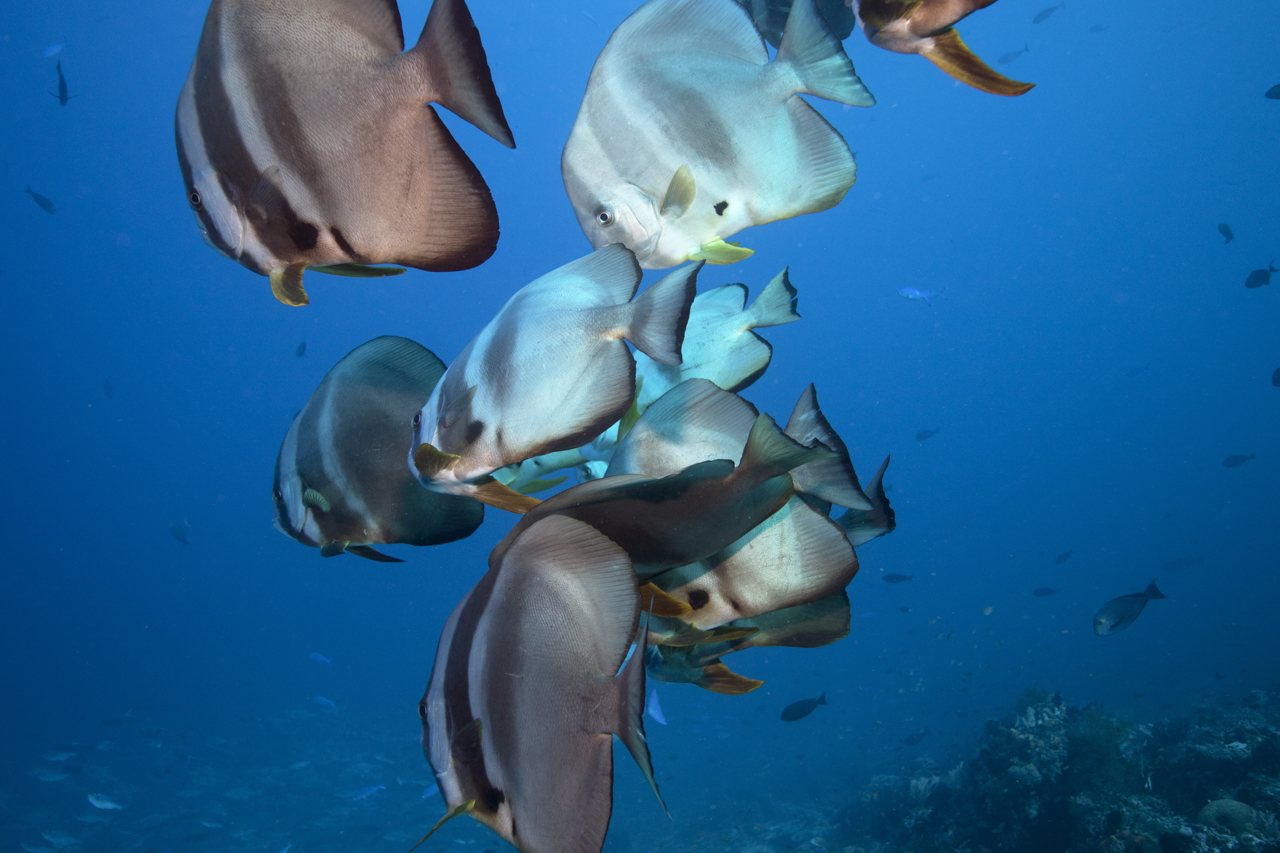
“Getting lost in the crowd”
A multitude of listing batfish among which I swam
Raja Ampat, Indonesia, August 2015
A multitude of listing batfish among which I swam
Raja Ampat, Indonesia, August 2015
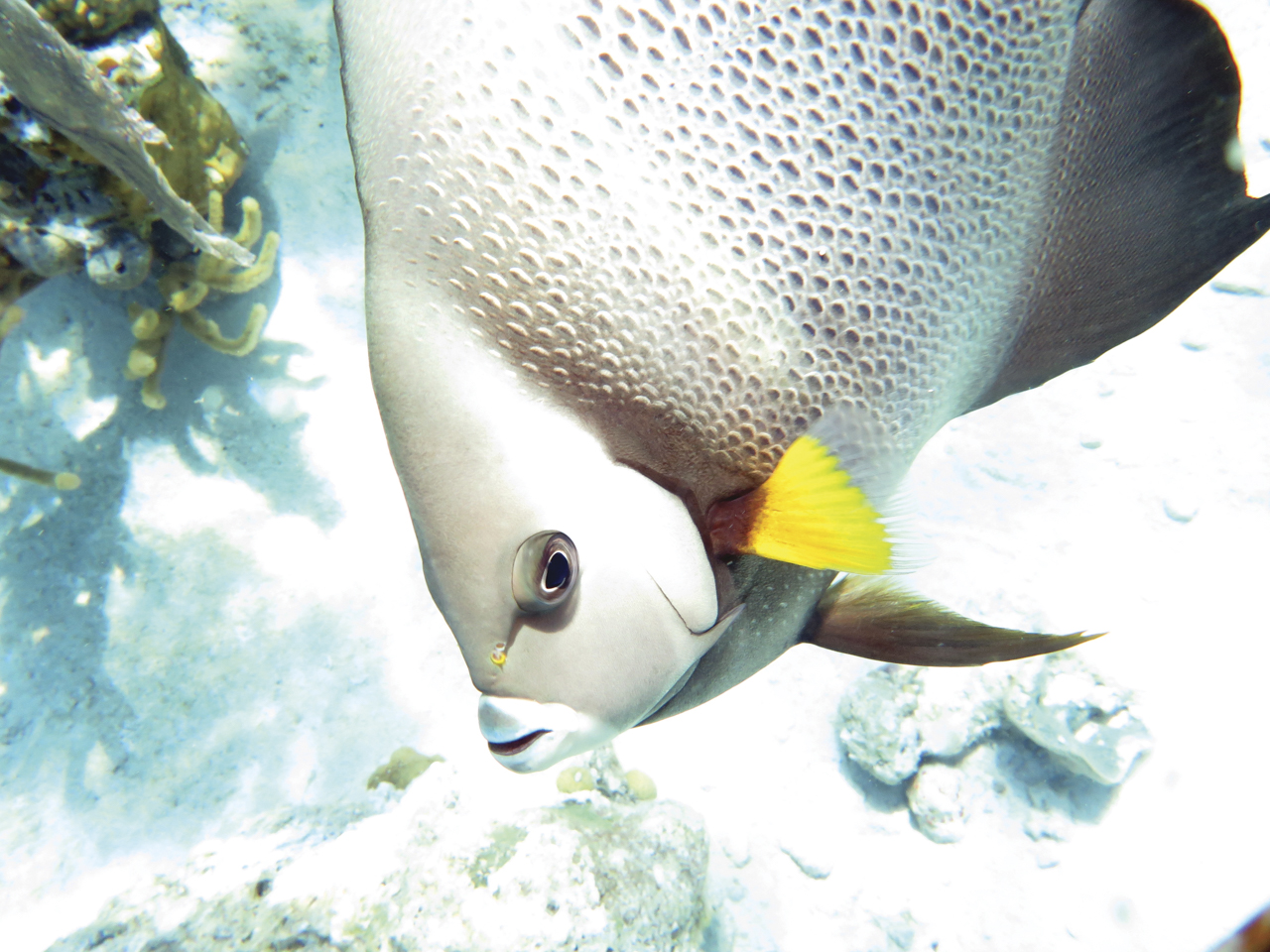
An overexposed Grey Angelfish up close
At “The Aquarium” site, the Exumas, April 2014
Grey Angelfish, like so many others including Emperor and Queen Angelfish, have the fascinating characteristic of having 3 distinct colour phases during their lifecycle: juvenile, intermediary or subadult, and adult.
Every phase is attractive and one can actually see the changes take place over time.
There are no ugly angelfish in my book and I cared for many species and individuals in my aquarium-laden youth.
I would advise anyone to look up Emperor, Queen, Six-Bar, Yellow-Masked, Blue-Girdled, Koran, Map, Regal, and French Angelfish during their free time!
At “The Aquarium” site, the Exumas, April 2014
Grey Angelfish, like so many others including Emperor and Queen Angelfish, have the fascinating characteristic of having 3 distinct colour phases during their lifecycle: juvenile, intermediary or subadult, and adult.
Every phase is attractive and one can actually see the changes take place over time.
There are no ugly angelfish in my book and I cared for many species and individuals in my aquarium-laden youth.
I would advise anyone to look up Emperor, Queen, Six-Bar, Yellow-Masked, Blue-Girdled, Koran, Map, Regal, and French Angelfish during their free time!
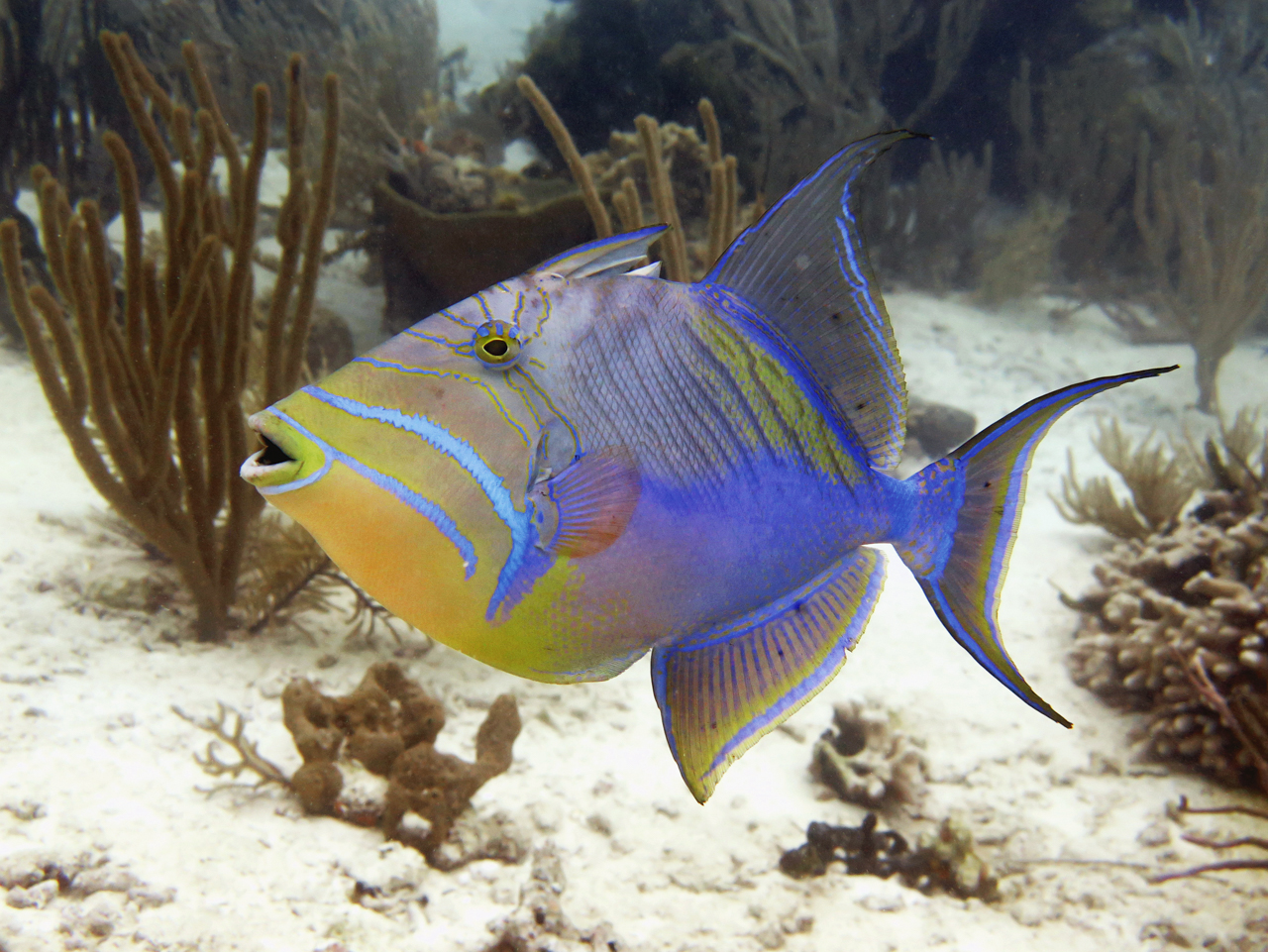
My second favourite queen!
The two nicest looking fish in the Caribbean are the Queen Triggerfish and Queen Angelfish.
The Bahamas, April 2014
Triggerfish are fascinating for several reasons, one of which is the presence of a distinct trigger that can be raised and lowered at will on their backs.
Purportedly triggerfish use this feature to block themselves inside coral or rock to avoid predators.
Otherwise you’ll notice the trigger move during certain moods or behaviours – such as aggression or excitement.
Triggerfish also have a very strong bite! They tend to feed on creatures with protective shells and spines such as crustaceans and sea urchins.
One and only one species can be aggressive towards humans: the Titan triggerfish. Titans grow to 75 centimetres, are indisputably dominant on the reef and attack divers who venture too close to their nests or fry. Completely fearless, a friend of mine was attacked by one on a trip we took together to Malaysia… repeatedly chasing her and biting her flippers. And apparently a tourist who was there two weeks before us had to have 9 stitches in his head!
It sometimes seems like no matter how far away from a titan you swim it will keep chasing after you. A friend told me recently that they heard the Titan Triggerfish’s territory is funnel shaped, wider at the surface than among the corals below, which would explain the repeated aggression while you swim away high up above the nest.
There are approximately 40 species of triggerfish around the world, most of them dwelling in tropical waters.
They are quite common in the aquarium hobby and many - such as the Clown, Picasso, Gilded and Queen above — are exquisite creatures.
One nice thing about keeping triggerfish – though I will never own a saltwater tank again and advise against them – is that they are very sturdy.
The two nicest looking fish in the Caribbean are the Queen Triggerfish and Queen Angelfish.
The Bahamas, April 2014
Triggerfish are fascinating for several reasons, one of which is the presence of a distinct trigger that can be raised and lowered at will on their backs.
Purportedly triggerfish use this feature to block themselves inside coral or rock to avoid predators.
Otherwise you’ll notice the trigger move during certain moods or behaviours – such as aggression or excitement.
Triggerfish also have a very strong bite! They tend to feed on creatures with protective shells and spines such as crustaceans and sea urchins.
One and only one species can be aggressive towards humans: the Titan triggerfish. Titans grow to 75 centimetres, are indisputably dominant on the reef and attack divers who venture too close to their nests or fry. Completely fearless, a friend of mine was attacked by one on a trip we took together to Malaysia… repeatedly chasing her and biting her flippers. And apparently a tourist who was there two weeks before us had to have 9 stitches in his head!
It sometimes seems like no matter how far away from a titan you swim it will keep chasing after you. A friend told me recently that they heard the Titan Triggerfish’s territory is funnel shaped, wider at the surface than among the corals below, which would explain the repeated aggression while you swim away high up above the nest.
There are approximately 40 species of triggerfish around the world, most of them dwelling in tropical waters.
They are quite common in the aquarium hobby and many - such as the Clown, Picasso, Gilded and Queen above — are exquisite creatures.
One nice thing about keeping triggerfish – though I will never own a saltwater tank again and advise against them – is that they are very sturdy.
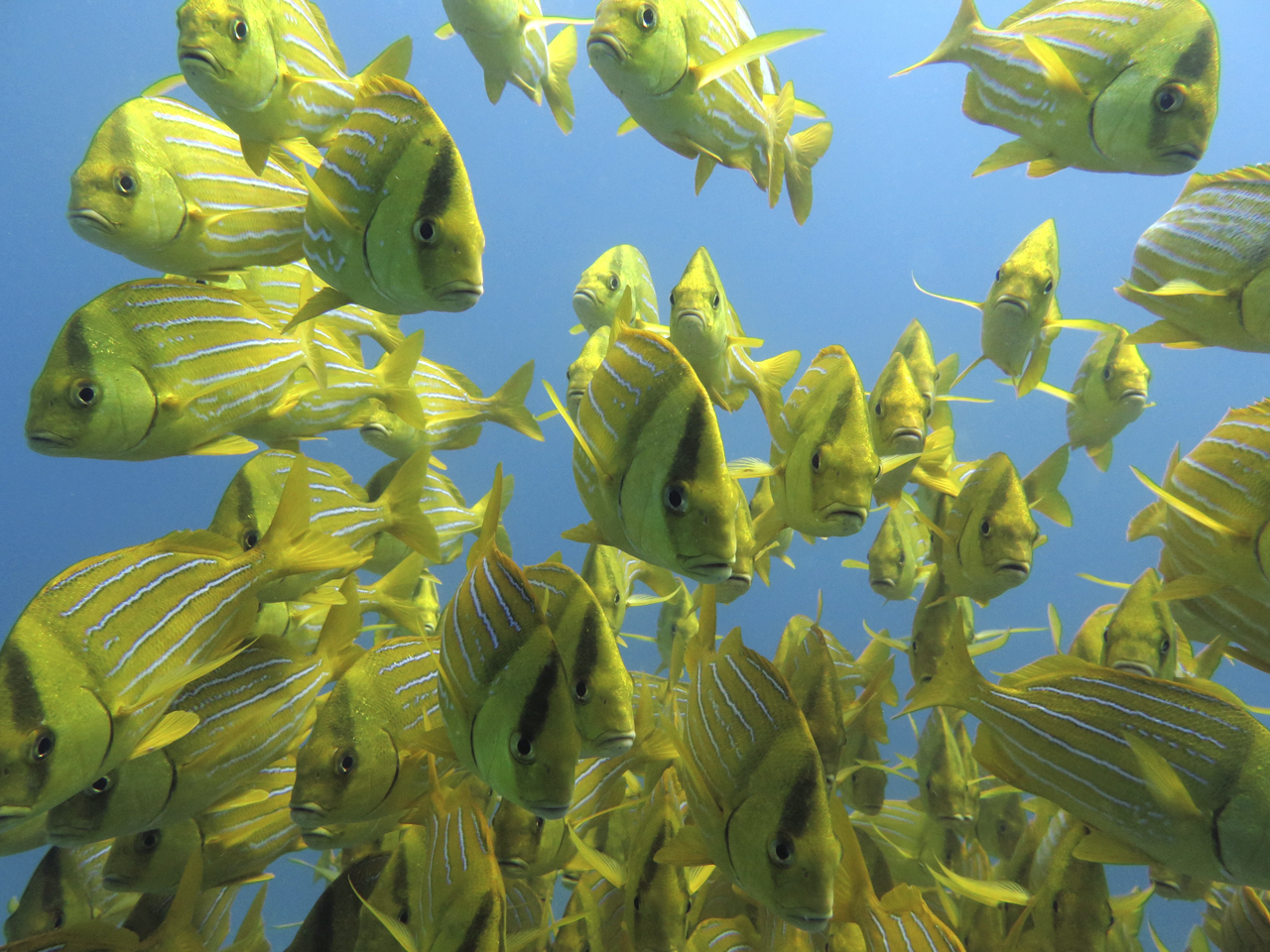
The famous school of Porkfish at Cabo Pulmo in Mexico, March 2014
Cabo Pulmo is an amazing no-catch MPA – marine protected area – which recently celebrated the 20th anniversary of its creation.
It has proven the case that MPAs, particularly no-catch ones, work since Pulmo has experienced a 400% increase in biomass since it was established.
Beyond this success story, and the limit placed on diver numbers at its now-famous sites, Cabo Pulmo is remarkable for its gorgeous and numerous shoals of fish. Everything from the porkfish above to Amarillo and other Snappers to the gigantic, ever-moving and bustling group of bigeye jacks, which you can see in another frame in the Living Sea exhibition and which Octavio Aburto famously captured in his image “David and Goliath”.
It was very pleasant to spend about ten minutes with and photograph the school of porkfish you see here, and I hope you’ll enjoy this image as much as I enjoyed taking it.
Cabo Pulmo is an amazing no-catch MPA – marine protected area – which recently celebrated the 20th anniversary of its creation.
It has proven the case that MPAs, particularly no-catch ones, work since Pulmo has experienced a 400% increase in biomass since it was established.
Beyond this success story, and the limit placed on diver numbers at its now-famous sites, Cabo Pulmo is remarkable for its gorgeous and numerous shoals of fish. Everything from the porkfish above to Amarillo and other Snappers to the gigantic, ever-moving and bustling group of bigeye jacks, which you can see in another frame in the Living Sea exhibition and which Octavio Aburto famously captured in his image “David and Goliath”.
It was very pleasant to spend about ten minutes with and photograph the school of porkfish you see here, and I hope you’ll enjoy this image as much as I enjoyed taking it.
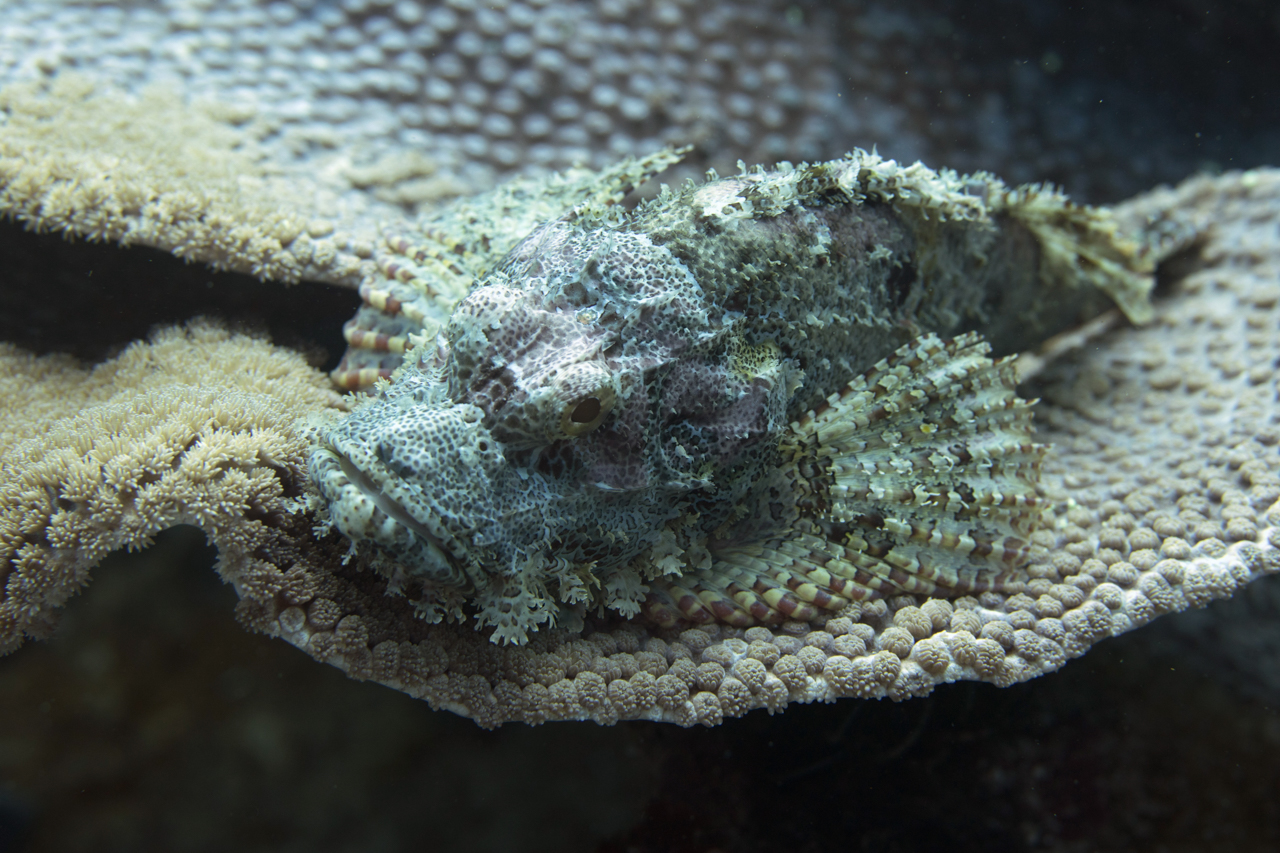
Probably a Raggy Scorpionfish confident in his disguise, ideally set up to be framed.
Raja Ampat, Indonesia, August 2015
Many people, certainly in Europe, would call this a “stonefish” and not a scorpionfish…
But anywhere from Lembeh to Bunaken, Raja Ampat or the Philippines, they’re referred to as scorpionfish.
There are literally dozens of species of scorpionfish in the Coral Triangle and, generally, the South Pacific.
Supremely disguised and often ideally positioned like this one, you often swim past one, totally unaware of its presence until your guide points it out.
Scorpionfish all have venomous spines that can give nasty stings and cause massive swelling and pain.
Luckily most divers will never suffer this pain. Scorpions stay hidden, nestled in the reef, and only hurt you as a defense mechanism.
Raja Ampat, Indonesia, August 2015
Many people, certainly in Europe, would call this a “stonefish” and not a scorpionfish…
But anywhere from Lembeh to Bunaken, Raja Ampat or the Philippines, they’re referred to as scorpionfish.
There are literally dozens of species of scorpionfish in the Coral Triangle and, generally, the South Pacific.
Supremely disguised and often ideally positioned like this one, you often swim past one, totally unaware of its presence until your guide points it out.
Scorpionfish all have venomous spines that can give nasty stings and cause massive swelling and pain.
Luckily most divers will never suffer this pain. Scorpions stay hidden, nestled in the reef, and only hurt you as a defense mechanism.
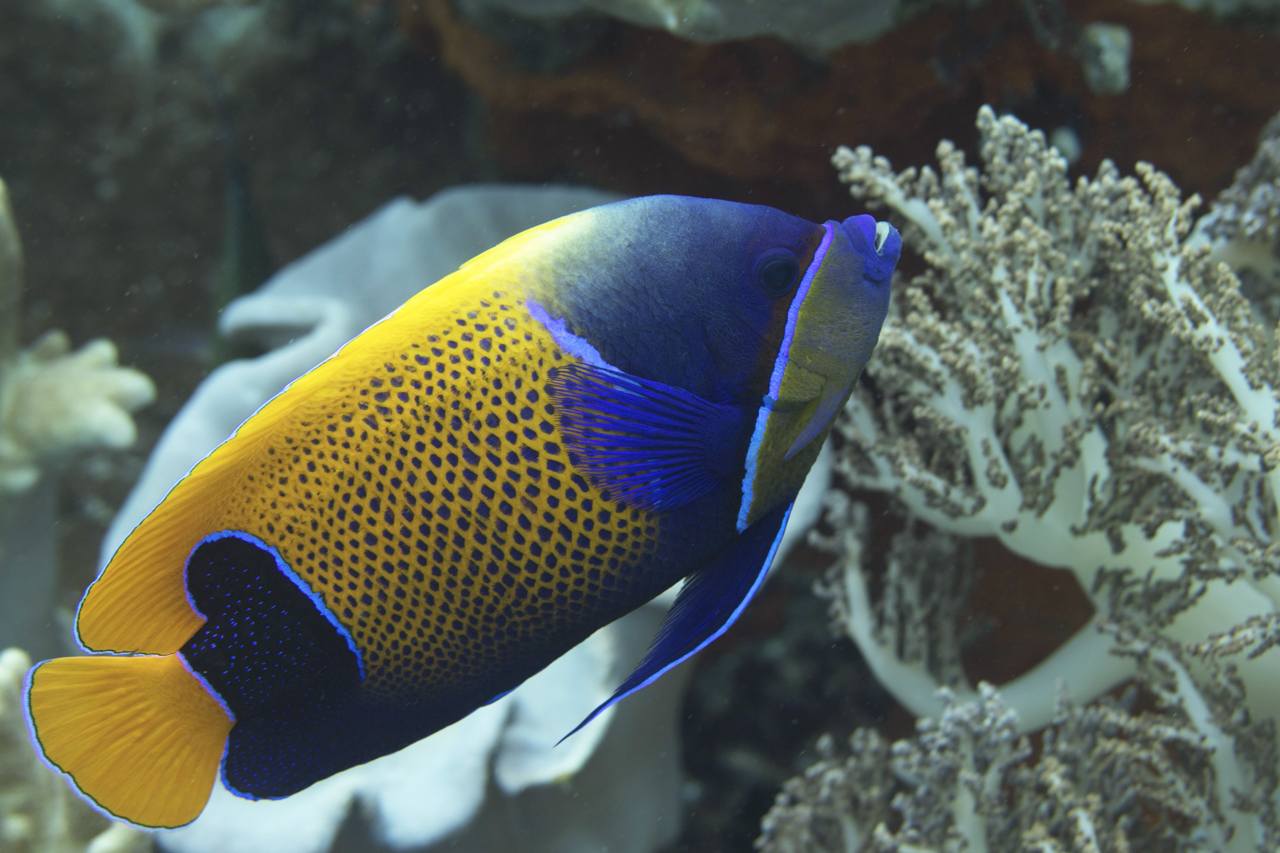
A Blue-Girdled Angelfish diagonal among soft corals
Raja Ampat (“the last paradise”), West Papua, August 2015
Blue-Girdled angelfish and their cousins, yellow-masked angels and six-bar angels, are among the most beautiful fish on the reef and some of my favourites.
It’s worth celebrating every time you see one of them!
I got to know these fish well when I had saltwater tanks in my late teens: they were common in the aquarium industry, and I owned many.
Now I wouldn’t dream of keeping a saltwater aquarium, given the mortality rates and cruelty involved all the way up the chain from fisherman to exporter to shopkeeper to buyer – and the damage done to populations in the wild.
But I do love seeing representatives of my favourite past pets swimming freely and interacting in their natural habitat.
Capturing them with my camera has become a special treat.
(it’s worth noting that, damselfish and a few clownfish species aside, no reef fish breed in captivity. So with the aquarium industry you’re effectively buying fish that were taken right out of the ocean, probably as colourful adults rather than less attractive juveniles. And frequently these fish are caught in terribly cruel ways, like with cyanide and dynamite that kill 90% of the creatures they come into contact with, and they often don’t adapt to captivity or feed themselves in it. In fact, something like 75-90% of the saltwater fish caught for the tropical fish trade die by the time the 10% end up in personal aquaria.)
Raja Ampat (“the last paradise”), West Papua, August 2015
Blue-Girdled angelfish and their cousins, yellow-masked angels and six-bar angels, are among the most beautiful fish on the reef and some of my favourites.
It’s worth celebrating every time you see one of them!
I got to know these fish well when I had saltwater tanks in my late teens: they were common in the aquarium industry, and I owned many.
Now I wouldn’t dream of keeping a saltwater aquarium, given the mortality rates and cruelty involved all the way up the chain from fisherman to exporter to shopkeeper to buyer – and the damage done to populations in the wild.
But I do love seeing representatives of my favourite past pets swimming freely and interacting in their natural habitat.
Capturing them with my camera has become a special treat.
(it’s worth noting that, damselfish and a few clownfish species aside, no reef fish breed in captivity. So with the aquarium industry you’re effectively buying fish that were taken right out of the ocean, probably as colourful adults rather than less attractive juveniles. And frequently these fish are caught in terribly cruel ways, like with cyanide and dynamite that kill 90% of the creatures they come into contact with, and they often don’t adapt to captivity or feed themselves in it. In fact, something like 75-90% of the saltwater fish caught for the tropical fish trade die by the time the 10% end up in personal aquaria.)
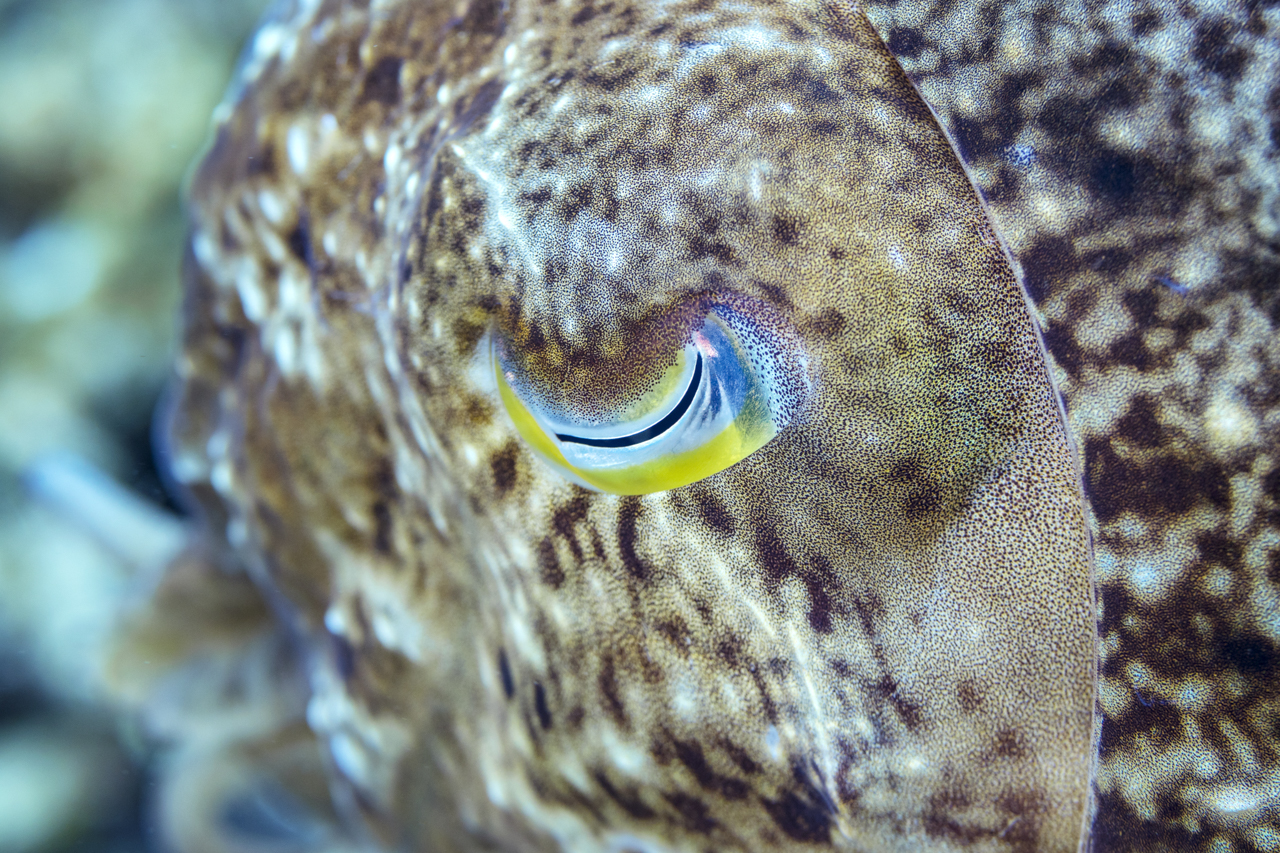
“The Eye”
Huge Cuttlefish in Raja Ampat, August 2015
There were a couple, probably a mating pair, in fairly shallow water and in a sort of flat clearing/depression at the top of the reef, at the very end of a dive – when I was probably low on air.
My friends Zeph, Trevor and Maria also enjoyed the sight of these amazing, very large creatures for over 5 minutes.
I didn’t want to leave these animals at all! I would have been happy to finish my air with them.
They weren’t in the least bit shy – and let me come within a meter 50 of them, maybe even closer.
I shot them like crazy! Dozens of frames from multiple angles. Back, side, top, front, face, eye, tentacles.
I don’t know which species this was… “Giant Cuttlefish” are in Australia and very famous in one spot where they mate.
You often see incredible, and some award-winning, photographs of Giant Cuttlefish courtship and mating there.
Whilst we weren’t in Australia, most species of undersea life have a range of at least a few countries.
I doubt there are multiple species of cuttlefish that get this big… so they might be giants!
Huge Cuttlefish in Raja Ampat, August 2015
There were a couple, probably a mating pair, in fairly shallow water and in a sort of flat clearing/depression at the top of the reef, at the very end of a dive – when I was probably low on air.
My friends Zeph, Trevor and Maria also enjoyed the sight of these amazing, very large creatures for over 5 minutes.
I didn’t want to leave these animals at all! I would have been happy to finish my air with them.
They weren’t in the least bit shy – and let me come within a meter 50 of them, maybe even closer.
I shot them like crazy! Dozens of frames from multiple angles. Back, side, top, front, face, eye, tentacles.
I don’t know which species this was… “Giant Cuttlefish” are in Australia and very famous in one spot where they mate.
You often see incredible, and some award-winning, photographs of Giant Cuttlefish courtship and mating there.
Whilst we weren’t in Australia, most species of undersea life have a range of at least a few countries.
I doubt there are multiple species of cuttlefish that get this big… so they might be giants!
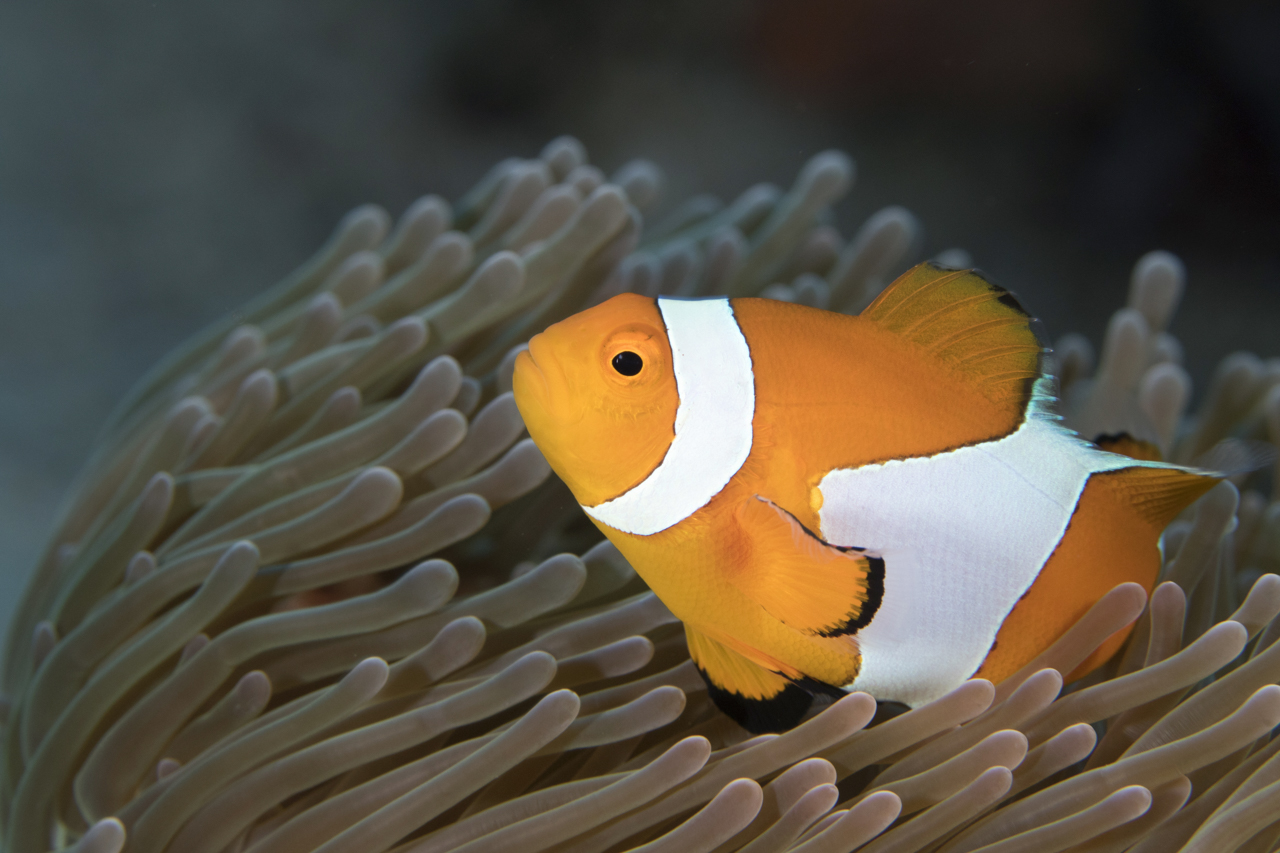
See Nemo in the comfort of his home!
Amphiprion ocellaris in Raja Ampat, West Papua, August 2015
One of my favourite species – along with A. perideraion and A. akallopisos — A. ocellaris is probably the most frequently shown in the media and bought for aquaria.
Clownfish are extremely protective of their babies and families! In spite of their small size and very visible colour schemes (lack of camouflage) they will often swim right out of their host anemone – a meter or more – and try to bite you! At least scare you away. “You shall not pass!”
Clownfish are closely related to damselfish, which are also very common in the aquarium trade, and frequently share anemones with them.
The nicest thing to see with these is the babies! Both clownfish and damselfish babies are adorable as they swim around in the anemone, interact with their loving parents and each other. Clownfish don’t grow big anyway – no more than 11 centimetres – but seeing tiny ones in their safe houses never fails to leave an impression.
One of my favourite species – along with A. perideraion and A. akallopisos — A. ocellaris is probably the most frequently shown in the media and bought for aquaria.
Clownfish are extremely protective of their babies and families! In spite of their small size and very visible colour schemes (lack of camouflage) they will often swim right out of their host anemone – a meter or more – and try to bite you! At least scare you away. “You shall not pass!”
Clownfish are closely related to damselfish, which are also very common in the aquarium trade, and frequently share anemones with them.
The nicest thing to see with these is the babies! Both clownfish and damselfish babies are adorable as they swim around in the anemone, interact with their loving parents and each other. Clownfish don’t grow big anyway – no more than 11 centimetres – but seeing tiny ones in their safe houses never fails to leave an impression.
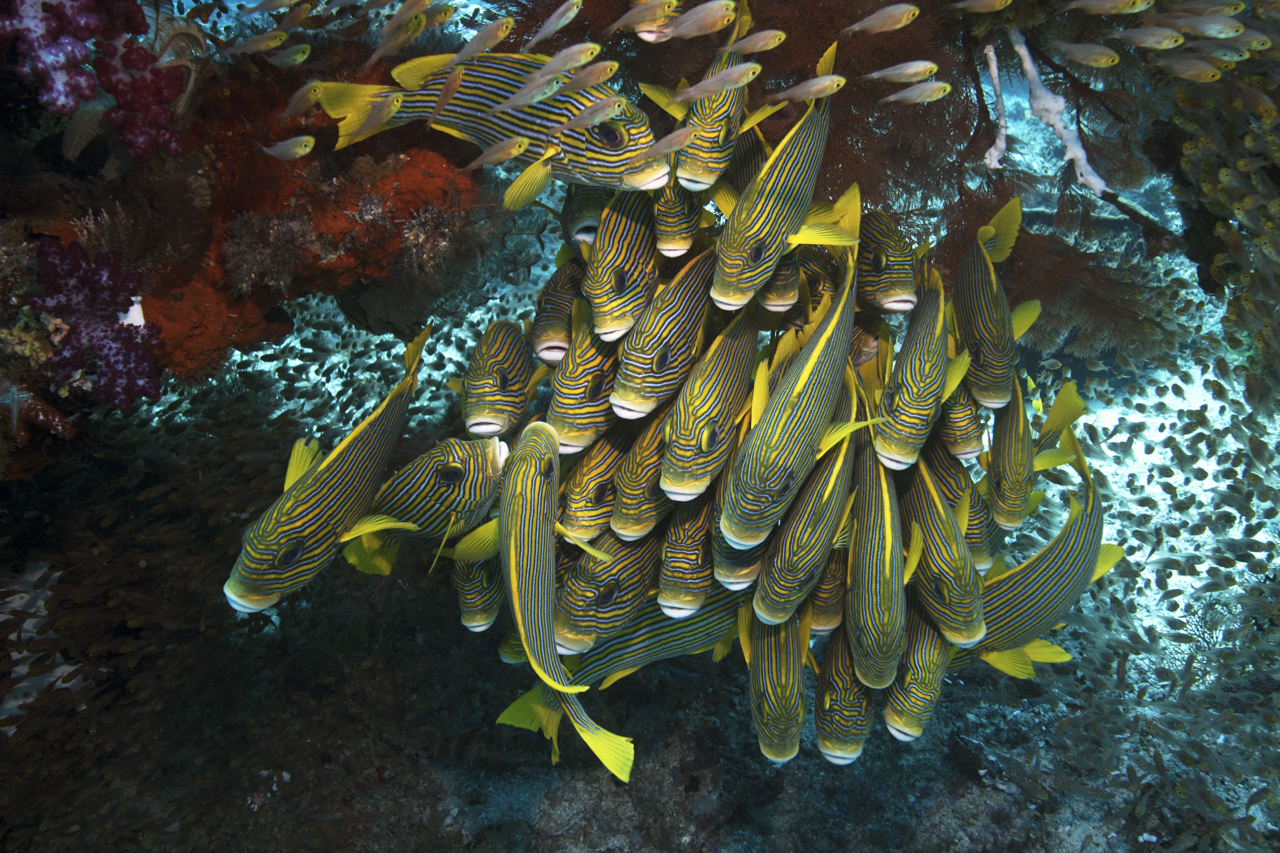
The famous Sweetlips among hundreds of Glass Fish
At a small overhang in Raja Ampat, West Papua, August 2015
The sweetlips are beautiful and in a tightknit group; glass fish fascinating and numerous, the mass of them ever shifting shape.
The guides in Raja all know this place and take divers there all the time.
There couldn’t possibly be two places like it, and you couldn’t possibly forget it.
We were taken there by our guide Lius in one quick and easy journey to this specific part of the reef.
Guides know all the popular resident animals and where they live in a place like Raja Ampat or Lembeh.
Just as you would know where your favourite flower is in your garden or where your resident squirrel lives in a tree, they know where to take you for a sweetlips overhang, pygmy seahorses, a clown frogfish or soft coral crabs (2 of which, also in this exhibition, were on this dive).
Sometimes a dive site is named after its residents. For example a nudibranch stronghold in Lembeh is known as Nudi Retreat.
I shall never forget this place or these fish and hope to visit them again someday.
There are 31 species of sweetlips and every one I know is intriguing and colourful.
Wikipedia tells me, “These fish have big, fleshy lips and tend to live on coral reefs in the Indo-Pacific in small groups or pairs. They will often associate with other fishes of similar species; several species of sweetlips sometimes swim together. They are usually seen in clusters in nooks and crannies or under overhangs. At nightfall, they venture from their shelters to seek out their bottom-dwelling invertebrate prey, such as bristleworms, shrimps and small crabs.”
At a small overhang in Raja Ampat, West Papua, August 2015
The sweetlips are beautiful and in a tightknit group; glass fish fascinating and numerous, the mass of them ever shifting shape.
The guides in Raja all know this place and take divers there all the time.
There couldn’t possibly be two places like it, and you couldn’t possibly forget it.
We were taken there by our guide Lius in one quick and easy journey to this specific part of the reef.
Guides know all the popular resident animals and where they live in a place like Raja Ampat or Lembeh.
Just as you would know where your favourite flower is in your garden or where your resident squirrel lives in a tree, they know where to take you for a sweetlips overhang, pygmy seahorses, a clown frogfish or soft coral crabs (2 of which, also in this exhibition, were on this dive).
Sometimes a dive site is named after its residents. For example a nudibranch stronghold in Lembeh is known as Nudi Retreat.
I shall never forget this place or these fish and hope to visit them again someday.
There are 31 species of sweetlips and every one I know is intriguing and colourful.
Wikipedia tells me, “These fish have big, fleshy lips and tend to live on coral reefs in the Indo-Pacific in small groups or pairs. They will often associate with other fishes of similar species; several species of sweetlips sometimes swim together. They are usually seen in clusters in nooks and crannies or under overhangs. At nightfall, they venture from their shelters to seek out their bottom-dwelling invertebrate prey, such as bristleworms, shrimps and small crabs.”

The Glass Fish at the overhang in Raja Ampat, August 2015
Glass fish are fascinating, always in large numbers and much more common in some places than others.
As a diver you hear about them all the time.
I’d never seen them before so this was a real thrill for me.
We ended up seeing a lot of them in Raja.
This shot is of those living with the sweetlips that also feature in this exhibition.
The sweetlips were always in a compact shape but not hesitant to change positions, altering The shape of the group.
The glass fish, however, were INCREDIBLY coordinated and precise.
They formed a vertical wall at times, where not a single fish was a centimetre further out front than the others.
It was amazing to witness. An experience I shall remember for a very long time…
Glass fish are fascinating, always in large numbers and much more common in some places than others.
As a diver you hear about them all the time.
I’d never seen them before so this was a real thrill for me.
We ended up seeing a lot of them in Raja.
This shot is of those living with the sweetlips that also feature in this exhibition.
The sweetlips were always in a compact shape but not hesitant to change positions, altering The shape of the group.
The glass fish, however, were INCREDIBLY coordinated and precise.
They formed a vertical wall at times, where not a single fish was a centimetre further out front than the others.
It was amazing to witness. An experience I shall remember for a very long time…
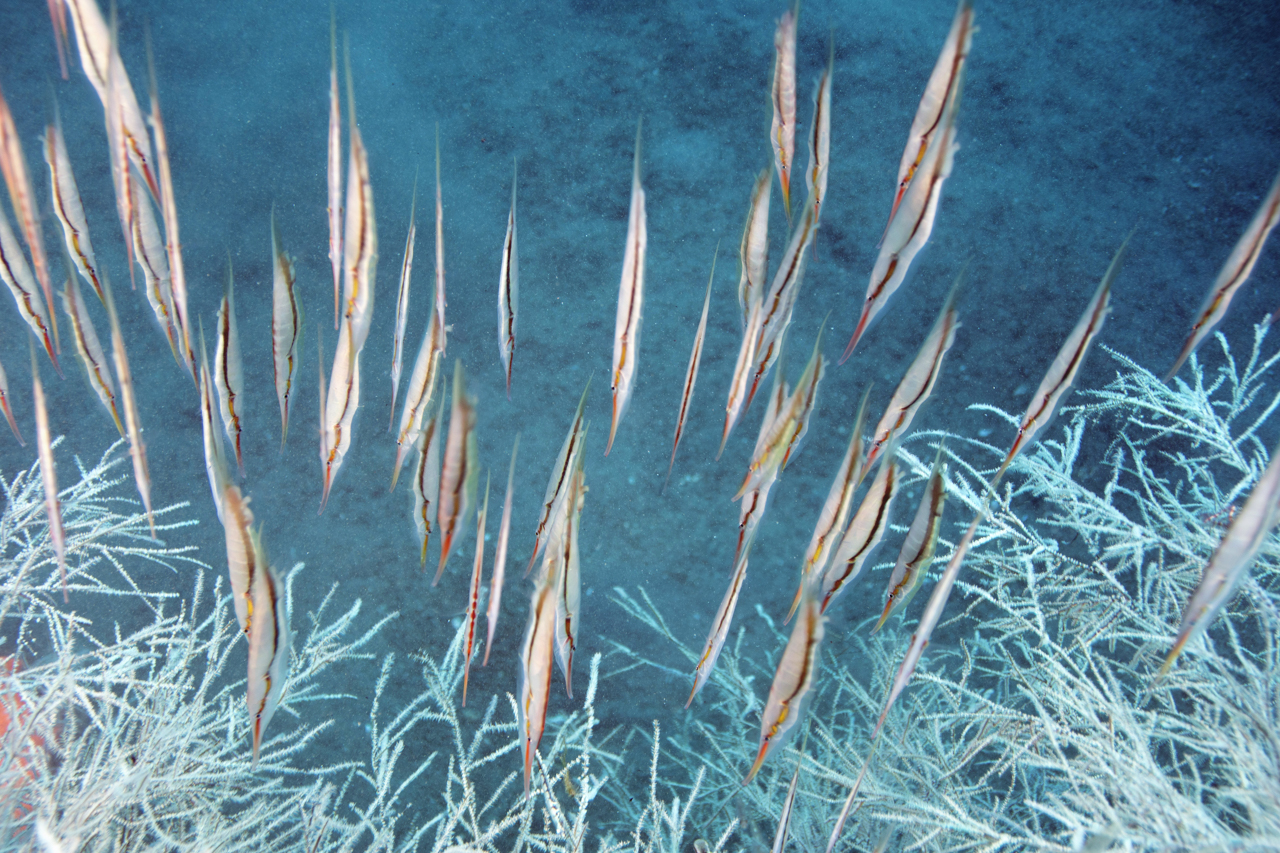
A small group of Razorfish, whose existence is upside down, hover over tall and willowy soft coral on the bottom.
Philippines, May 2017
You only ever really see razorfish in groups. The fewest I’ve seen together is 4; but you’ll see schools of up to 60 now and again.
Sometimes they’re split in multiple smaller groups.
They’re fun to watch as they practice synchronized swimming and move as one.
Their capacity to move laterally and inverted seems absolutely illogical.
Their unexpected ability to pick up speed is noteworthy as well.
Color varies significantly. “In a seagrass environment the background color of the body can be greenish-yellow with light brown stripes. In open areas like sand patches or rubble close to the reef the body coloration is light silver with a black to brown stripe.” — Wikipedia
Razorfish are adapted to hide among sea urchin spines from which they occasionally shoot out to catch their prey – small shrimp and invertebrates.
But I’ve seen them in or close to sea urchins very few times.
This particular group was deeper than I’d ever seen them before and very light in color. We stayed with them for a number of minutes, moving around them and trying to shoot from different angles. It was a beautiful sight, the fish impressive with their camouflage tactics.
They’re always hard to photograph because the camera tends to only focus on a few individuals, never the entire group. Or it focuses on the background instead of the fish.
Philippines, May 2017
You only ever really see razorfish in groups. The fewest I’ve seen together is 4; but you’ll see schools of up to 60 now and again.
Sometimes they’re split in multiple smaller groups.
They’re fun to watch as they practice synchronized swimming and move as one.
Their capacity to move laterally and inverted seems absolutely illogical.
Their unexpected ability to pick up speed is noteworthy as well.
Color varies significantly. “In a seagrass environment the background color of the body can be greenish-yellow with light brown stripes. In open areas like sand patches or rubble close to the reef the body coloration is light silver with a black to brown stripe.” — Wikipedia
Razorfish are adapted to hide among sea urchin spines from which they occasionally shoot out to catch their prey – small shrimp and invertebrates.
But I’ve seen them in or close to sea urchins very few times.
This particular group was deeper than I’d ever seen them before and very light in color. We stayed with them for a number of minutes, moving around them and trying to shoot from different angles. It was a beautiful sight, the fish impressive with their camouflage tactics.
They’re always hard to photograph because the camera tends to only focus on a few individuals, never the entire group. Or it focuses on the background instead of the fish.

“For a long time, this dive was not spectacular” or “one stands out with flash”
Huge shoal of Jacks at Isla del Coco, June 2017
This is the second biggest shoal I’ve ever witnessed.
On an expedition to Cocos in Costa Rica – which is an incredible stronghold of scalloped hammerhead sharks (as are the Galapagos) and also features whitetip reef sharks, Galapagos sharks and tiger sharks as well as large pelagics and shoals of fish -- no dive was really uninteresting; but many were fairly deep.
The dive in this image was quite deep and dark and also quite uneventful. It was one of those dives where even though your tank is quite full you’re already looking forward to surfacing.
Just as boredom was setting in and the idea of seeing something phenomenal was well out of mind, my eye was drawn to this gigantic, twirling and shape-shifting school of jacks a few dozen meters away.
There were thousands of huge, lazy-looking but sociable and socialized fish!
In such instances you feel minute.
I spent a good 10 minutes swimming around this mass of fish and trying to get good images.
A few of the shots, including this one, are very nice.
Many frames, on the other hand, feature the disgusting part of a shoal: excrement.
It is mathematically and physically impossible for such an enormous number of creatures not to leave things behind as they go.
For that reason the jacks looked much better from afar than they did up close.
It was not always a pretty sight from less than 20 meters away. Not always possible to get as clear a view as in this image.
Regardless, what felt like a wasted dive transformed into something magnificent, practically unimaginable, that also yielded wonderful material.
By far the largest shoal I have been in the water with was the mass of bigeye jacks at Cabo Pulmo in Mexico in 2018, also featured in this exhibition.
Huge shoal of Jacks at Isla del Coco, June 2017
This is the second biggest shoal I’ve ever witnessed.
On an expedition to Cocos in Costa Rica – which is an incredible stronghold of scalloped hammerhead sharks (as are the Galapagos) and also features whitetip reef sharks, Galapagos sharks and tiger sharks as well as large pelagics and shoals of fish -- no dive was really uninteresting; but many were fairly deep.
The dive in this image was quite deep and dark and also quite uneventful. It was one of those dives where even though your tank is quite full you’re already looking forward to surfacing.
Just as boredom was setting in and the idea of seeing something phenomenal was well out of mind, my eye was drawn to this gigantic, twirling and shape-shifting school of jacks a few dozen meters away.
There were thousands of huge, lazy-looking but sociable and socialized fish!
In such instances you feel minute.
I spent a good 10 minutes swimming around this mass of fish and trying to get good images.
A few of the shots, including this one, are very nice.
Many frames, on the other hand, feature the disgusting part of a shoal: excrement.
It is mathematically and physically impossible for such an enormous number of creatures not to leave things behind as they go.
For that reason the jacks looked much better from afar than they did up close.
It was not always a pretty sight from less than 20 meters away. Not always possible to get as clear a view as in this image.
Regardless, what felt like a wasted dive transformed into something magnificent, practically unimaginable, that also yielded wonderful material.
By far the largest shoal I have been in the water with was the mass of bigeye jacks at Cabo Pulmo in Mexico in 2018, also featured in this exhibition.

“The light shines through”
The myriad Bigeye Jacks of Cabo Pulmo that caused me to burn through my tank in 20 minutes
Mexico, August 2018
Thank God I was wearing my free-diving fins, which are longer and more powerful than the regular ones.
We were dropped off behind the shoal, which wasn’t the plan, and my buddy, wearing regular fins, couldn’t catch up.
The bigeye jacks of Pulmo are very famous.
Immortalized, as I repeat, in Octavio Aburto’s amazing “David and Goliath” image, there are thousands upon thousands of jacks in a shoal that I think must be 100 meters long, and is both wide and deep.
When you’re somewhere in the middle of the shoal (hard to assess) there are fish for at least 40 meters in front of you and at least 40 meters behind.
The fish, in parts of the shoal, reach from the surface all the way down to the sand 15-25 meters below.
The jacks aren’t that fast; but they’re not really slow either and they’re moving all the time.
You can’t slow down or they’ll be gone.
The shoal generally stays in the same area for days – and the guides of Pulmo tell each other where it was last spotted.
On my 4th or 5th jack dive spread over 2 different trips, and after nothing as spectacular, it was possible and THRILLING to stay with this huge mass of life, zig zag left and right, move up and down among innumerable magnificent creatures.
For a long time I was hovering over them, moving side to side, like a vigilant hawk.
Now and again I’d stop to turn around and shoot them from in front — as in this image.
It’s amazing, beyond description, to see thousands of fish coming at you — and for the experience to last more than a few seconds.
On either side of me I had 15 meters or more of fish!
The only thing about this dive was that, whereas a tank would usually last me 40-50 minutes at that depth, I was basically out of air in 20-23 minutes!
Swimming hard.
But you know what? The jack dive immediately after this one was just as spectacular – and my tank lasted 2-3 minutes more!
I’ve never seen a shoal of comparable size. The next best thing was more bigeye jacks off Cocos in Costa Rica, a frame of which also features in this exhibition.
The myriad Bigeye Jacks of Cabo Pulmo that caused me to burn through my tank in 20 minutes
Mexico, August 2018
Thank God I was wearing my free-diving fins, which are longer and more powerful than the regular ones.
We were dropped off behind the shoal, which wasn’t the plan, and my buddy, wearing regular fins, couldn’t catch up.
The bigeye jacks of Pulmo are very famous.
Immortalized, as I repeat, in Octavio Aburto’s amazing “David and Goliath” image, there are thousands upon thousands of jacks in a shoal that I think must be 100 meters long, and is both wide and deep.
When you’re somewhere in the middle of the shoal (hard to assess) there are fish for at least 40 meters in front of you and at least 40 meters behind.
The fish, in parts of the shoal, reach from the surface all the way down to the sand 15-25 meters below.
The jacks aren’t that fast; but they’re not really slow either and they’re moving all the time.
You can’t slow down or they’ll be gone.
The shoal generally stays in the same area for days – and the guides of Pulmo tell each other where it was last spotted.
On my 4th or 5th jack dive spread over 2 different trips, and after nothing as spectacular, it was possible and THRILLING to stay with this huge mass of life, zig zag left and right, move up and down among innumerable magnificent creatures.
For a long time I was hovering over them, moving side to side, like a vigilant hawk.
Now and again I’d stop to turn around and shoot them from in front — as in this image.
It’s amazing, beyond description, to see thousands of fish coming at you — and for the experience to last more than a few seconds.
On either side of me I had 15 meters or more of fish!
The only thing about this dive was that, whereas a tank would usually last me 40-50 minutes at that depth, I was basically out of air in 20-23 minutes!
Swimming hard.
But you know what? The jack dive immediately after this one was just as spectacular – and my tank lasted 2-3 minutes more!
I’ve never seen a shoal of comparable size. The next best thing was more bigeye jacks off Cocos in Costa Rica, a frame of which also features in this exhibition.
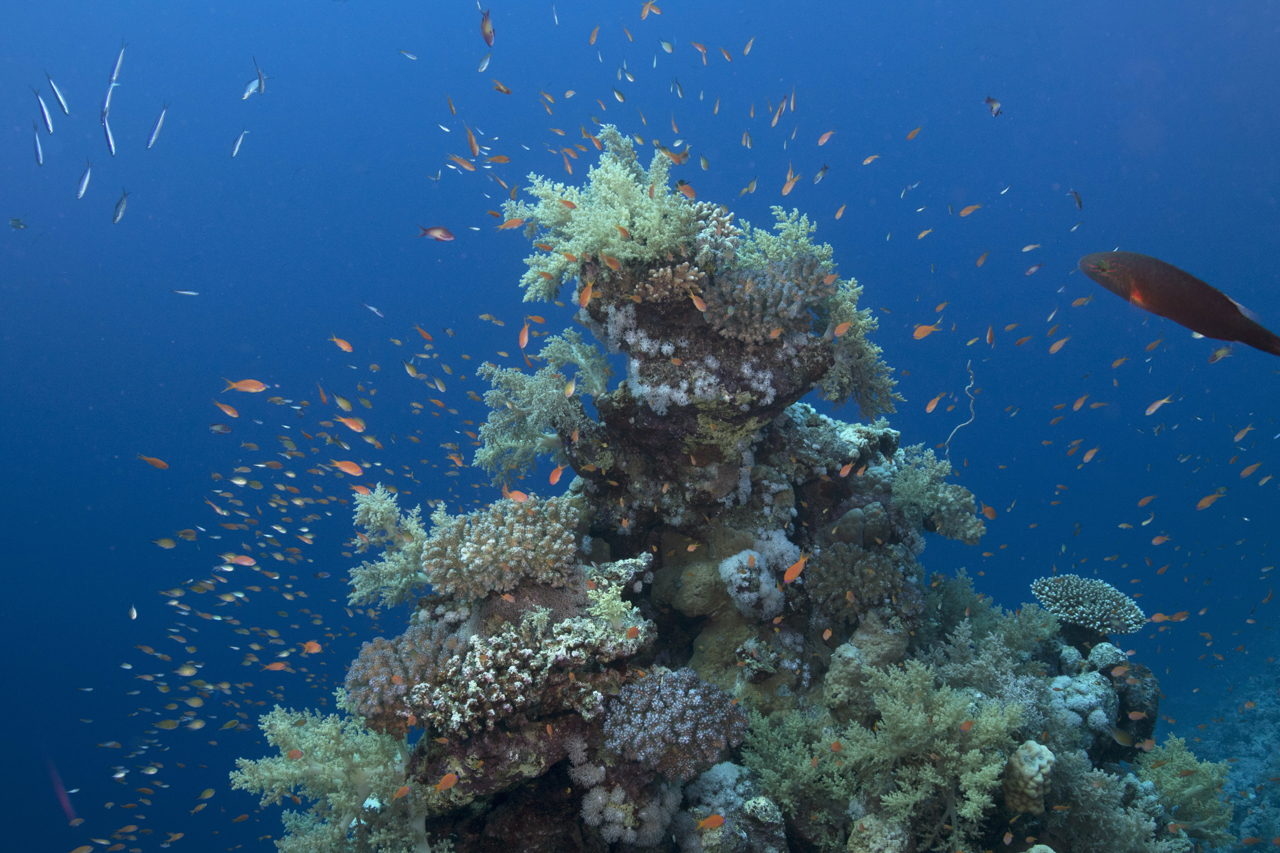
A multitude of hard and soft corals on a reef outcrop, replete with Anthias and a visiting Cheek-lined Wrasse
Egypt, November 2018
The Red Sea and the Maldives live and breathe Anthias fish! Swarms of them are everywhere.
They crowd, carpet and cloud the reef.
Some of, maybe the most common reef fish, Anthias (or “basslets”) populate all tropical oceans and seas. If you include other genera, such as Pseudanthias and Odontanthias, there are at least 70 different species of them.
Egypt, November 2018
The Red Sea and the Maldives live and breathe Anthias fish! Swarms of them are everywhere.
They crowd, carpet and cloud the reef.
Some of, maybe the most common reef fish, Anthias (or “basslets”) populate all tropical oceans and seas. If you include other genera, such as Pseudanthias and Odontanthias, there are at least 70 different species of them.

Tiny Damselfish in and over coral
The Sataya reef, Egypt, November 2018
Every shape was better and each fish prettier than the one before!
There must have been 3 pieces of coral in which dozens of little damselfish were living close to each other.
In each case, the fish rose and descended as one in a united cloud.
It was so beautiful – and variable.
I stayed for minutes because the situation was stunning from every angle, each fish adding to a gorgeous puzzle, every movement and cloud formation different to the one before it. It seemed like the fish were synchronized no matter where you looked…
The Sataya reef, Egypt, November 2018
Every shape was better and each fish prettier than the one before!
There must have been 3 pieces of coral in which dozens of little damselfish were living close to each other.
In each case, the fish rose and descended as one in a united cloud.
It was so beautiful – and variable.
I stayed for minutes because the situation was stunning from every angle, each fish adding to a gorgeous puzzle, every movement and cloud formation different to the one before it. It seemed like the fish were synchronized no matter where you looked…
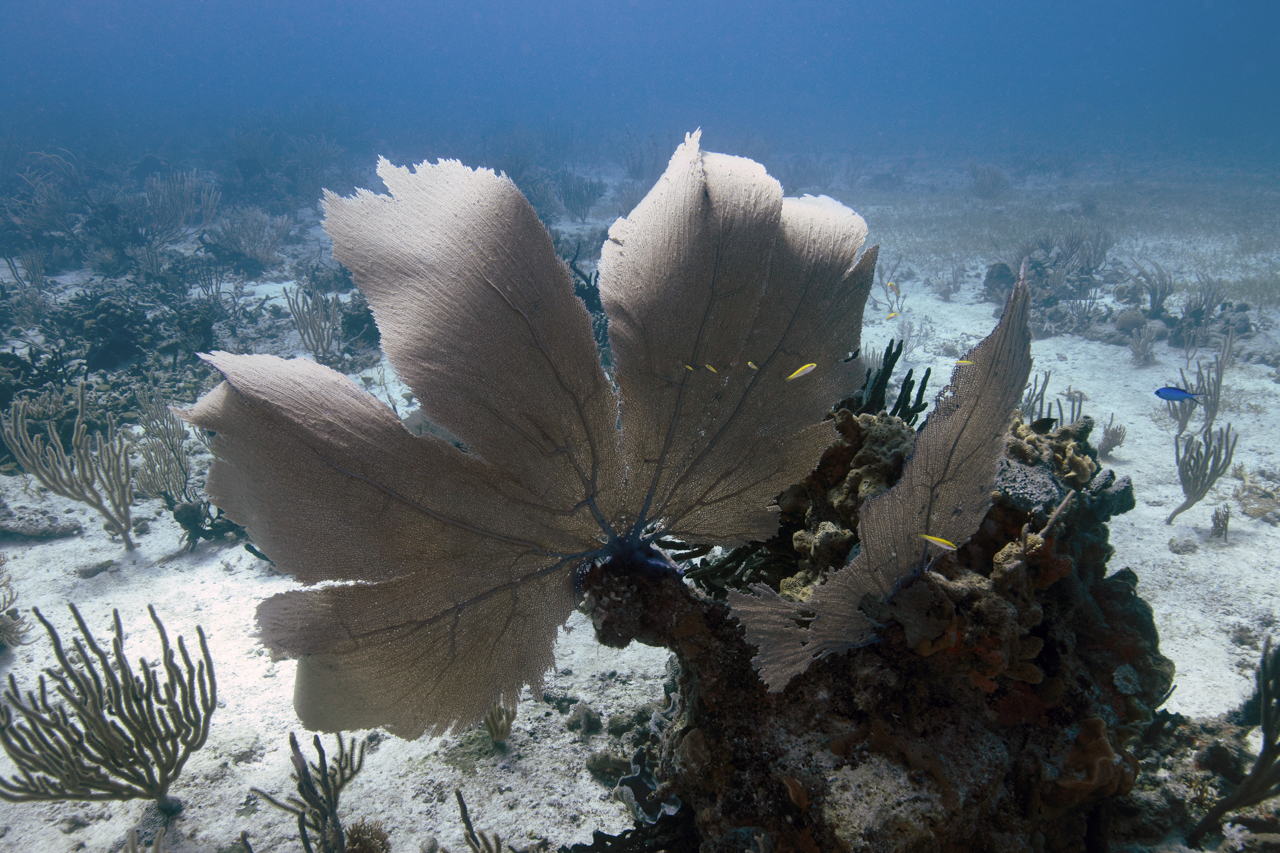
A sea fan photographed at a site named Conch Cut in the Exumas in April 2019
Sea fans can be particularly beautiful.
I love the blue ones.
Sometimes you see very big sea fans, making the experience all the better.
And you frequently see Flamingo Tongues, absolutely beautiful snails, stuck to them.
The other thing is sea fans are particularly photogenic, and they look good from every angle.
Sea fans can be particularly beautiful.
I love the blue ones.
Sometimes you see very big sea fans, making the experience all the better.
And you frequently see Flamingo Tongues, absolutely beautiful snails, stuck to them.
The other thing is sea fans are particularly photogenic, and they look good from every angle.
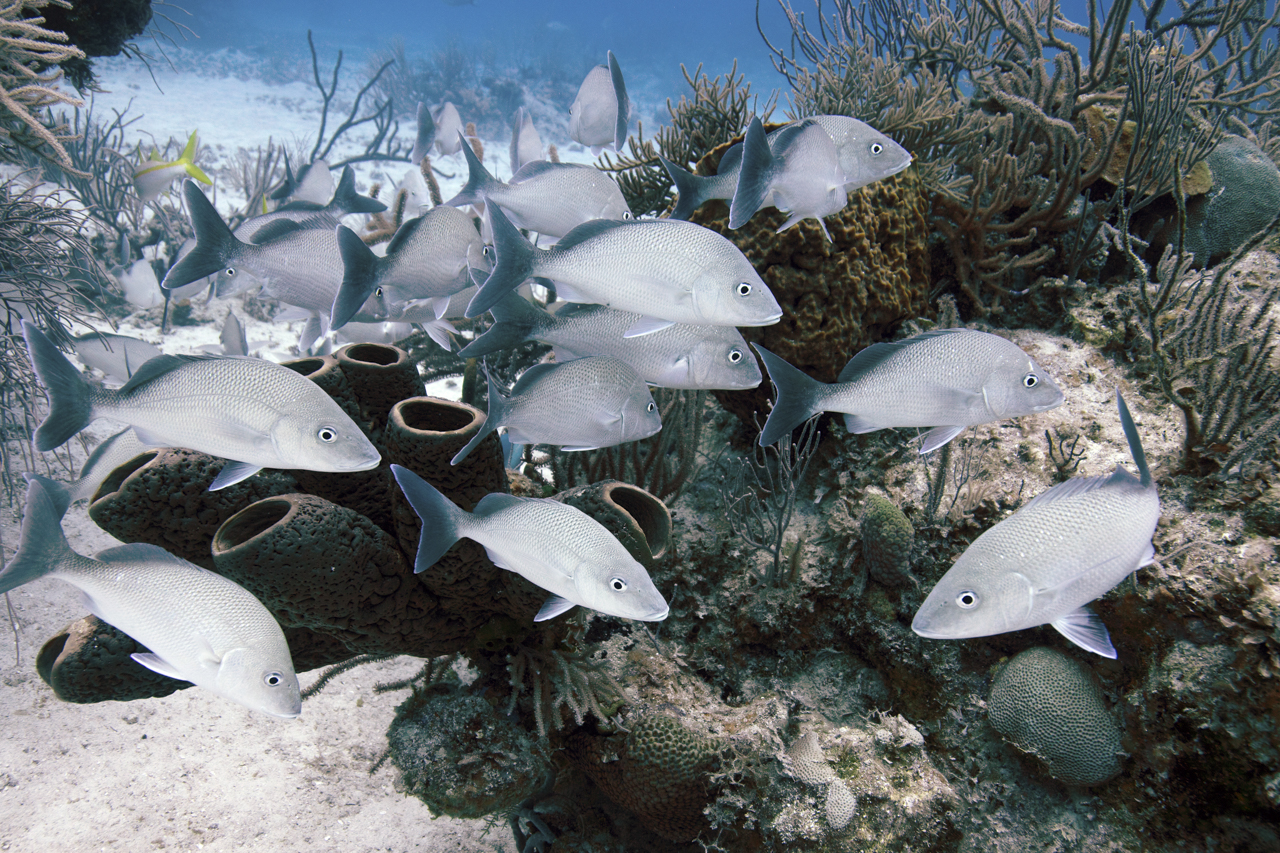
A small group of Margate fish that are always in the same spot – around 2-3 coral heads – at “the Aquarium” in the Exumas, April 2019
It’s nice that some things never change and some animals, even wild ones, are predictable.
The Aquarium is only 5 minutes from home and my friends, relatives and I go there all the time. We all know the regulars – 1) “my” 3 beloved green turtles (I call them “Matilda”, “Monique” and “Melissa”!) who swim the same soft coral channel every day and love the same 2 adjacent coral heads, one big and one small, I usually find one or two of them sitting under at least half the time; 2) the fairly large school of grunts around 3 coral heads and often under a small arch — on the left side of the site; and 3) these Margate fish on the right side of the site – in shallow water, over pale sand and between coral heads that are more spaced out.
Sometimes you’ll get a transient nurse shark or spotted eagle ray at The Aquarium. Occasionally you see a moray eel. Frequently you get a large stingray.
It’s extremely rare to see any turtle other than “my” 3 greens and a medium hawksbill.
But the grunts and Margate fish are always there.
The Margates aren’t spectacular or colourful; but they are elegant. They’re immobile most of the time and move slowly when you approach – up to a point!
They’re surprisingly photogenic — and familiar.
It’s nice that some things never change and some animals, even wild ones, are predictable.
The Aquarium is only 5 minutes from home and my friends, relatives and I go there all the time. We all know the regulars – 1) “my” 3 beloved green turtles (I call them “Matilda”, “Monique” and “Melissa”!) who swim the same soft coral channel every day and love the same 2 adjacent coral heads, one big and one small, I usually find one or two of them sitting under at least half the time; 2) the fairly large school of grunts around 3 coral heads and often under a small arch — on the left side of the site; and 3) these Margate fish on the right side of the site – in shallow water, over pale sand and between coral heads that are more spaced out.
Sometimes you’ll get a transient nurse shark or spotted eagle ray at The Aquarium. Occasionally you see a moray eel. Frequently you get a large stingray.
It’s extremely rare to see any turtle other than “my” 3 greens and a medium hawksbill.
But the grunts and Margate fish are always there.
The Margates aren’t spectacular or colourful; but they are elegant. They’re immobile most of the time and move slowly when you approach – up to a point!
They’re surprisingly photogenic — and familiar.

A typical view of the reef, alive with countless Basslets, illuminated by the sun
Egypt, December 2019
The sun in this image makes all the difference.
Egypt, December 2019
The sun in this image makes all the difference.

Instant joy and ideal shot
Lionfish hovering over coral and among Anthias
Egypt, December 2019
Sometimes you just know – without a doubt – when something will turn out great.
It seems like most of the time one sees the spectacular when low on air, when the group is ending the dive and you have to follow… or both.
That was the case here.
I didn’t have tons of air left and I was trailing the group, who were swimming back to the boat.
But the lionfish was in this wonderful pose, high enough above the coral to see clear separation, and surrounded by Anthias, coral and colour.
It was so exciting that I approached a little too fast, causing the lionfish to descend towards the coral – sad because it looked so good higher up.
Since one doesn’t want to slow one’s friends and guides down – make them wait at the end of the dive – and my air was running out there was time enough only to take a few photographs. This one was the best of them.
Lionfish hovering over coral and among Anthias
Egypt, December 2019
Sometimes you just know – without a doubt – when something will turn out great.
It seems like most of the time one sees the spectacular when low on air, when the group is ending the dive and you have to follow… or both.
That was the case here.
I didn’t have tons of air left and I was trailing the group, who were swimming back to the boat.
But the lionfish was in this wonderful pose, high enough above the coral to see clear separation, and surrounded by Anthias, coral and colour.
It was so exciting that I approached a little too fast, causing the lionfish to descend towards the coral – sad because it looked so good higher up.
Since one doesn’t want to slow one’s friends and guides down – make them wait at the end of the dive – and my air was running out there was time enough only to take a few photographs. This one was the best of them.

